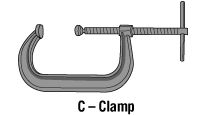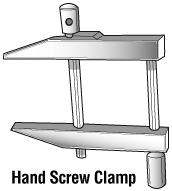Hand Tools - Clamps
On this page
What are examples of clamps?
Back to topClamps are versatile tools that serve to temporarily hold work securely in place. They are used for many applications including carpentry, woodworking, furniture making, welding, construction and metal working.
Clamp styles include C-clamps, bar clamps, pipe clamps, deep-throat bar clamp, one-handed bar clamps, spring clamp, ratchet-action band clamp, mitre clamp, and hand screws. Bar clamps have adjustable arms that are easily widened or narrowed to fit the workpiece and, therefore, requires fewer turns of the screw spindle, compared to a C-clamp, to hold the piece tightly.

Proper use of a bar clamp:
- Used for woodwork, especially for holding edges when gluing.
- Apply clamping pressure at right angles to the glue line otherwise slippage may result.

Proper use of a c-clamp:
- Used for carpentry, welding, or cutting.

Proper use of a hand screw clamp:
- Can be made of metal or wood.
- Used to hold small pieces or in furniture repair.
What are some general safety tips to know when using clamps?
Back to top- Wear safety glasses or goggles, or a face shield (with safety glasses or goggles).
- Select the proper clamp style and size by matching the work-holding requirements of the job with the following clamp features:
- strength and weight (e.g., consider rail size and nominal clamping pressure)
- opening (length of reach)
- throat depth (depth of reach)
- ease of adjustment
- clamping surfaces (material used and size)
- Ensure that the swivel at the end of the screw turns freely before using.
- Dispose of clamps with bent frames; replace bent spindles, if possible.
- Ensure that the pressure plate and anvil parts of the clamp are in full contact with the workpiece before tightening.
- Close the jaws until the clamp feels tight. For example, when gluing, some glue will be squeezed out, a sign that it is tight enough.
- Use pads with C-clamps to avoid marking the work.
.gif)
- Remove clamps as soon as the job is finished. Clamps serve only as temporary devices for holding work securely in place.
- Keep all moving parts of clamps lightly oiled and keep tools clean to prevent slippage. Also make sure there is no dirt or oil on any part that will come into contact with the work.
- Store C-clamps by clamping them in a rack, not in a drawer.
What should I avoid doing?
Back to top- Do not use extra large clamps just for the sake of their large throats. Instead, use, deep-throat clamps.
- Do not use any clamps that have a bent frame or a bent spindle.
- Do not use wrenches, pipes, hammers, or pliers to tighten clamps. Use wrenches only on clamps especially designed for wrenches.
- Do not hoist or pull with C-clamps. Use special lifting clamps.
- Do not use C-clamps to construct scaffolds or platforms for workers.
.gif)
Refer to OSH Answers General Hand Tool Operation for more tips.
- Fact sheet confirmed current: 2017-03-01
- Fact sheet last revised: 2013-08-28
